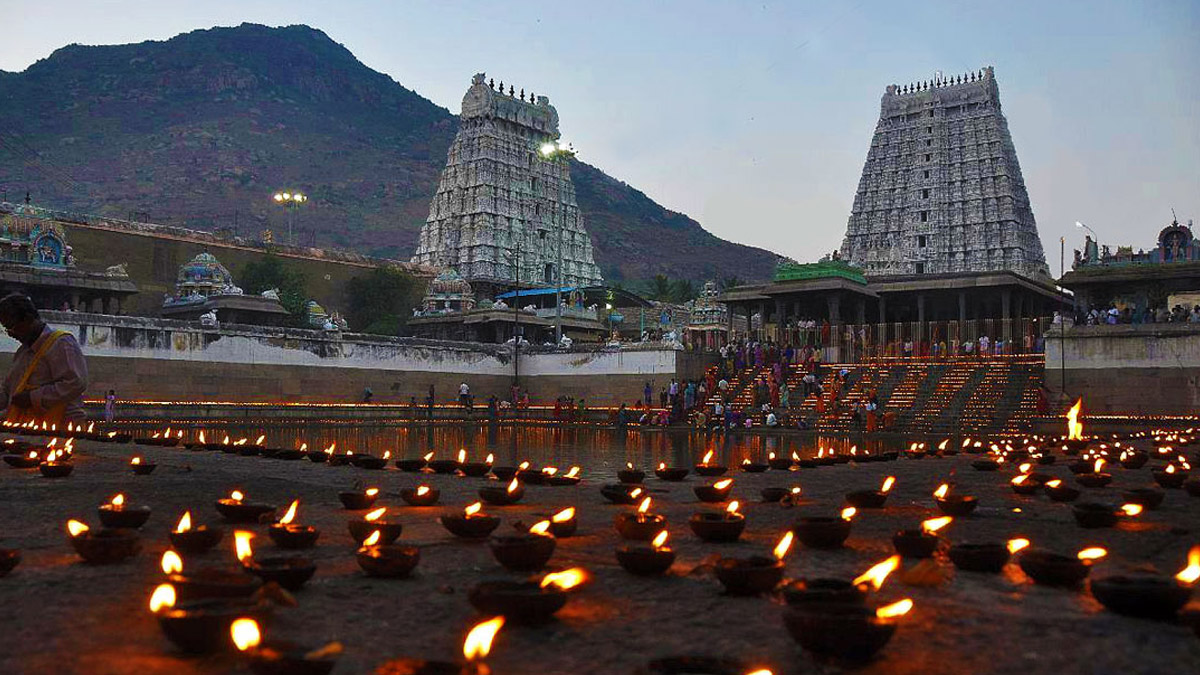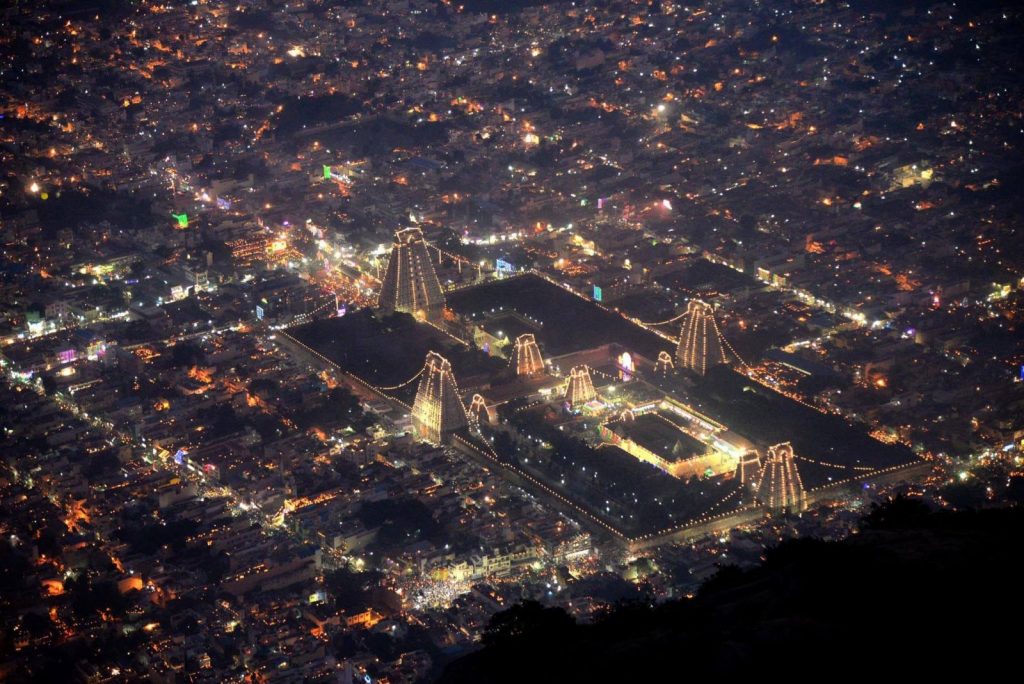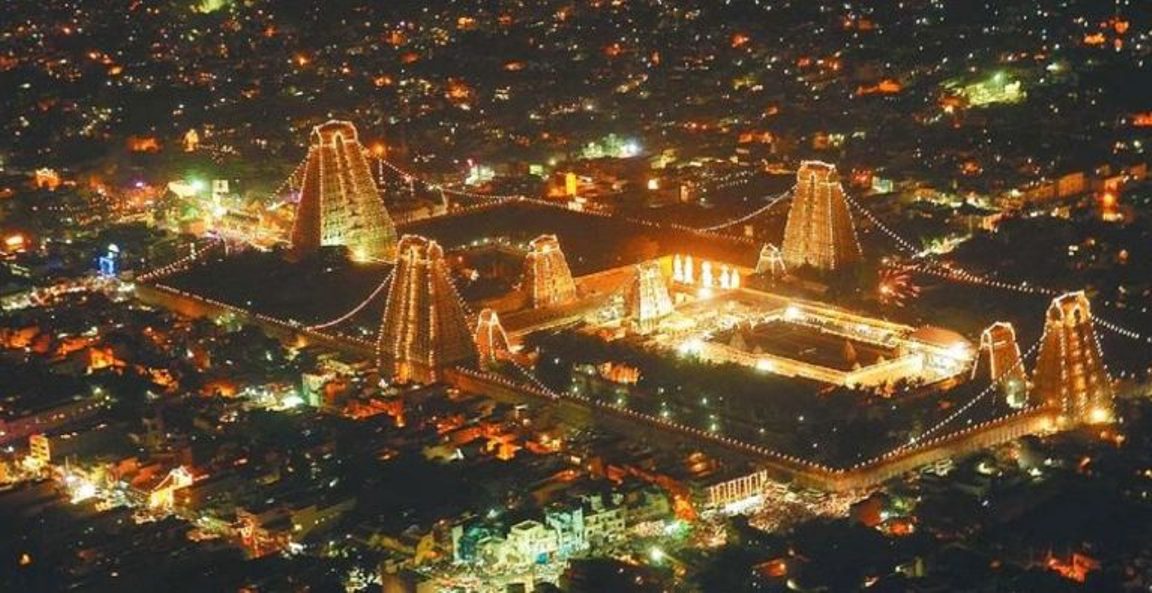Overview
Nestled 196 km away from the bustling state capital of Chennai, Tiruvannamalai stands as a revered temple city and a focal pilgrimage point in Tamil Nadu’s heart. The city’s spiritual pulse beats in rhythm with the renowned Annamalaiyar Temple, cradled by the sacred Annamalai Hill.

Amidst the divine resonance of temple bells and the sacred chants that echo through the city’s alleys lies an age-old festival that surpasses time—a continuing tradition and a jubilant celebration known as the Karthigai Deepam festival. This annual celebration, set against the backdrop of the majestic Annamalai Hill, elevates Tiruvannamalai to more than just a geographical location; it becomes a pilgrimage destination that breathes life into the spiritual tapestry of Tamil Nadu.
With no further ado, let us delve into the essence of this age-old festival. This annual spiritual festival weaves the threads of tradition, devotion, and celestial radiance.
What is the Karthigai Deepam Festival in Tamil Nadu?
The Karthigai Deepam Festival holds a special place in the hearts of Tamilnadu, emerging as one of the region’s most renowned and auspicious celebrations. Taking centre stage in the Tamil month of Karthigai, which spans the mid-November to December period, this festival is a vibrant expression of religious and spiritual fervour in the South Indian states. At its core, the Karthigai Deepam Festival is a radiant symbol of triumph over darkness, illuminating the path of joy and goodness.
While the Festival of Lamps graces all temples and homes with its luminous presence, the Tiruvannamalai Arunachaleswarar temple is an iconic beacon during this celebration. Devotees, numbering in the lakhs, converge upon this sacred site to witness the grandeur of the Karthigai Deepam Festival.

The Tiruvannamalai Arunachaleswarar temple, a cornerstone of South Indian religious heritage, is dedicated to Lord Shiva and revered as “Arunachaleswarar.”
The commencement of the 10-day celebration unfolds on the auspicious day of Uttradam with a grand gesture—the hoisting of the flag. Lord Arunachaleswarar graces the proceedings, carried in a majestic procession atop the silver vahanas, symbolising a divine journey that marks the beginning of a sacred festivity.
As the festivities reach their crescendo, the tenth day witnesses the illumination of the renowned Bharani Deepam, accompanied by its five “Agni Deepams,” in the sacred temple of Arunachaleswarar’s Sannithi. The culmination of the celebration unfolds on the festival’s last day, drawing lakhs of devotees to the Annamalai Hills.
The festival unfolds in all its magnificence during the full moon day between November and December, transforming the temple into a sacred haven of light and spirituality. Atop the hill, a colossal beacon is kindled amid a sea of reverent souls, casting its luminous glow across the landscape—a symbolic gesture that signifies the essence of the Karthigai Deepam Festival in this spiritual oasis.
The lighting of the Maha Deepam
The lighting of the Maha Deepam atop the towering 2,668-foot Annamalai Hill is a spectacle that unfolds with meticulous precision and immense devotion.

The journey of the cauldron, a colossal vessel measuring 10 feet in height and 5 feet in width, commences a day before the grand event. Carried aloft by 65 individuals, the cauldron embarks on a seven-kilometre ascent, navigating a route to reach its destination.
This extraordinary vessel carried on poles holds 4500 kg of pure ghee within its colossal frame. A wick, extending over 1000 meters and made of a unique cotton cloth, is carefully inserted into the cauldron, awaiting the transformative moment.

The ceremony itself is a harmonious symphony of tradition and reverence. With the aid of fire from kilograms of camphor, the Maha Deepam is ignited, casting a radiant glow that transcends the physical boundaries of the hill. Its brilliance is not confined; it is visible in a remarkable radius of 35 kilometres, serving as a luminous beacon that resonates far and wide.
What makes this celestial flame even more remarkable is its resilience. Defying the whims of winds and the temperamental nature of rains, the fire within the Maha Deepam remains alive for 11 days. It stands as a testament to the enduring spirit of the festival, symbolising the unwavering light that persists in the face of external challenges—a spiritual flame that continues to illuminate hearts and minds, undeterred by the forces of nature.
In a magnificent display of devotion, lakhs of devotees embark on a sacred pilgrimage around the revered Annamalai Hill— the 16 km circumambulation known as Girivalam. The residual ash, known as “Mai”, left behind after the ceremonial lighting of the ghee during the Karthigai Deepam Festival, infused with the divine energy of the festival, is distributed as prasad—a blessed offering—to the devotees.
History of the Age-Old Celebration
The roots of Karthigai Deepam extend deep into the annals of time, woven into the cultural tapestry of ancient traditions. While the exact historical narrative may be veiled in the passage of ages, fragments of its essence are discovered in the whispers of ancient writings. References to this auspicious occasion, a festival of lights that transcends generations, echo in the age-old literary treasure of the Tamils—Ahananuru.
Ahananuru, a collection of poems, stands as a venerable repository of Tamil wisdom, recounting the tales and traditions of an era that unfolded between 200 BC and 300 AD. Within its verses, this celebration finds its place. Even the illustrious Avaiyyar, a renowned woman of the Sangam age, lends her poetic voice to the Karthigai Deepam in her verses, further enriching the historical narrative of this luminous festival.
The Legend behind Karthigai Deepam
An ancient myth echoing through the ages revealed a divine competition among the gods Vishnu and Brahma. As the rivalry peaked, a radiant flame emerged, revealing Shiva. In a challenge, Shiva urged the gods to uncover the flame’s origin.
As a swan, Brahma soared skyward, while Vishnu transformed into Varaha (a boar), delving into the earth. Yet, neither could unveil the mystery. When Brahma falsely claimed success, Shiva ordained that Brahma would have no earthly temples.
This myth laid the foundation for the names of the city and hill. “Arunam” means red or fire, and “Asalam” signifies hill in Tamil. As Shiva manifested as fire here, the place became Arunachalam, intertwining the city and Annamalai hill with this ancient tale.
For the devout Hindus, the reverence for Karthigai Deepam is intertwined with their unwavering faith in Lord Shiva. He is not merely a deity but a guardian, a protector of the world, and a beacon of divine solace.
Conclusion
In Tiruvannamalai, where tradition and spirituality intertwine, the Karthigai Deepam Festival stands as a testament to the rich cultural heritage of India. As the age-old rituals unfold this evening, this celebration is not merely an event but a living tradition that transcends time.
As Indians, it is not just our privilege but our duty to learn and preserve these timeless traditions. In this celebration, we find a reflection of the cultural richness passed down through generations. It is a call to embrace, cherish, and safeguard these invaluable traditions that form the very essence of our identity. In doing so, we contribute to the continuity of a legacy that transcends time, allowing the flame of tradition to illuminate the path for future generations.











